#would 100% do this if I knew even the basics of making an animatic
Explore tagged Tumblr posts
Note
There's always time Cozy!!!
You're doing so well already, and your work and little posts mean a lot to us!! I know it doesn't always seem like it, but there are people who might consider hearing about your day or seeing your art as little drops of joy
So... maybe it's not a lot, but it means a lot to someone, somewhere
Lots of affection (/platonic) from this little anon
then hear about my week.
today i went out and instead of spending 55 bucks on meager groceries i spent 35 on meager groceries because the majority of what i got was “buy one get one free” — not much of a ratio and still expensive but 20 bucks less is 20 bucks less i suppose
but this came after i bought a humidifier only for it to show up like it sustained a freaking bullet wound either during or before shipping but nobody gave a shit. It’s muskrats America so maybe my humidifier DID get shot. it’s cheaper to just crack a window for some humidity in my room. Refund imminent.
two days ago i finished my last art trade from that follower raffle i did (i know i never posted the art i did receive- its not my style but i loved all of them, but tbf most of my recipients didn’t either so i suppose it balances out)
today i finished 75% of my emergency comms from days ago. there’s only one left. after that i’ll finally have a clear plate for the first time in months
i was sick most of the week with a cold (at least i think it was)
still doing the twst oc outfit art meme. tho im slowing down on purpose since im pretty confident that the only person who even likes the challenge is me. Pretty sure all the askers are only doing it out of pity anyhow since im not giving gen art. It’s not nearly as in demand as like…that old wardrobe art meme with all the fake cards and to think…
those are basically obsolete since ⚠️the game started room relaxation on jp and i realized how off base i truly was 👌👍 good thing i never finished. But i was tired of making thankless stuff anyway.
i cleared out my inbox yesterday cuz i knew i would never get back to anything (mainly ask memes i failed completing)
so now instead of 150+ unanswered messages its now a more humble 100 unanswered messages (mind half of that is just my own personal archived bs from like 2017)
Speaking of thankless, there was still drawing other peoples yuu requests in there from 2023. Pretty sure all those askers dont even like twst anymore and the majority of ones i did do never touched my work again. Always makes a homie remember that one is only useful to others so long as you can give them free stuff 👍
the only art that gives me joy is the stuff that i never post.
book 7 makes me frown now but not for the reasons people might automatically jump to but i already vowed never to voice mundane takes or reflections again because [redacted] [noun_error_notfound?] are [adjective_error_notfound(?)] if anyone says anything innocuous
I made tikka masala today.
world bad and i wanna get off of it
i stream drawing art in a discord server with one single other person in it and they are forced to listen to sonic game OSTs until they memorize the games they come from
art bad im never gonna be as good as the ones that sometimes manage to cross my purposely dead dashboard cuz i simply have no sense and have a “just making sure i dont fit in” complex where i dont wanna draw whatever is trendy
i did not put this under read more
i watched a bunch of bratz movies and episodes yesterday and i did not know they made some new mini-series continuation of their main continuity 😭 (apparently it was tiktok exclusive so ofc i didnt know. i dont use that.) so that gave me some joy.
speaking of toktik i was informed that someone apparently reposted my malleus and silver animatic up there >:(
i get a.i references when asked to draw stuff now i and dont like it because a.i but also because i cant read the images well as a result.
maybe people shouldn’t do that, idk.
And i didnt draw for myself today. That was my week.
#cozy ask#this is also the same site where leaving responsive tags is getting more and more and more scarce#so even if something like art is dropped i wouldnt know what anyone thinks.
15 notes
·
View notes
Note
please tell us how Brutus is a c!Karl song i would love to hear you out
Okayokayokayokay. So I understand that a lot of people never watched c!Karl’s lore pre-TFTSMP however there is a really good analysis video of him on YouTube that explains it really well, and it was made before doomsday even happened.
But to sum it up: c!Karl really wanted to be involved in the lore. He was always trying to be a part of the big stuff, and he even comments on it during c!Niki’s birthday party, when c!Wilbur is about to blow Manberg up (You can actually hear him say ‘wait, am I part of a big event for once?’) Sad-ist’s meme animatic Dre Smp was made because there was a whole bit about Karl wanting to be included.
Later, c!Karl made Rutabag-Ville while the Pogtopia war was going down (this is actually the context in which c!Techno chased c!Quackity and gave That Speech) and eventually annexed it to c!Schlatt. Why? Well, he’d wanted to join Pogtopia, but had been turned down, I believe it was even specifically by c!Quackity.
Later, c!Quackity and c!Tubbo confronted him over this decision, and he eventually said that he sided with c!Schlatt because he felt welcome and c!Schlatt was nice to him. Now, obviously, we all know this was manipulation, and it’s my own little headcanon that c!Karl knew subconsciously what he was doing, but wanted to be accepted so badly he didn’t care.
This also extends beyond the Pogtopia war. I think not a lot of people actually know that Karl was part of the New L’Manberg government as its creative head, but he was left out of every discussion by the rest of the cabinet (we got ROBBED of butcher army c!Karl). He expresses bitterness over this readily! One thing I forgot to mention earlier is that he actually did try to get people on Manberg’s side back in the war by giving them gifts, but they always burned them when he left.
He also founded El Rapids during this time with c!Sapnap, c!Quackity, and c!George. Some drama happened, and in order to assert their nations independence, Karl sacrificed one of his lives by blowing up part of his country in order to frame Eret for it.
(side note, but fun fact; c!Karl was the one who snitched to c!Dream about c!Eret helping Pogtopia, which is what got c!George on the throne. Just a little fun fact.)
Of course, his lore does kinda peter out after that. His CC began streaming TFTSMP, and we know how that went. Not to say he never streamed at all, but they became a lot rarer since a lot of the server began to think they needed more scripted lore, thus their standards for streaming became higher.
I also agree with the headcanon that he has FOMO (Fear Of Missing Out) and while you could say that this was just his CC wanting to be in more lore, you would be right, but if we brushed off character’s lore because the CC wasn’t 100% in-character, we would have very little characterization left. A lot of Karl’s characters comes from before the 4th wall had really solidified on the server, plus it comes from late-2020, while a lot of newer fans got into the smp around early to mid 2021.
Basically, Brutus is a song about envy, hatred, and a whole lot of mixed emotions based on the assassination of Julius Caesar. While c!Karl never went to the extremes Brutus did, it’s not really hard to see how closely the song echoes his treatment on the server.
I tend to divide c!Karl’s characterization into three parts; first is his more immature and young personality that is set during the Manberg to El Rapids era, second is his transitioning phase between that and someone a bit more mature, which I put from Doomsday to The Pit (the eighth TFTSMP episode), and third is his more mature characterization, where he is burdened by his time traveler duties and has grown into his own person, past the need to be important and make an impact, though the shadow of Manberg and El Rapids loom over him.
In short, c!Karl is a nuanced character who faced the curse of fanon and lost. But hey, so did everyone else. I’d argue he got some of the worst of it, though C!Ranboo is a tough contender. So is C!Sam, actually. And c!Fundy. Just… a lot of characters got the short stick by fanon.
This is my first shot at making an essay, so it’s a bit messy. A lot of this can be found on vod channels, however, so if anyone wants to give links feel free to do so! Also you can correct me if I got anything wrong, it has been a hot minute since I’ve watched a DSMP vod.
That’s my two cents, anyhow. I just really like c!Karl and feel like he got done dirty by a lot of fans. They really did take a nuanced character who was both selfless and selfish, kind yet a bit of a sadist, loved to mess with his loved ones but also hated when anyone touched them, and turned him into a little soft boy who can’t defend himself against anything or One Of c!Quackity’s Mean Crazy Ex-Fiancés. No, I am not exaggerating, I saw someone legitimately call c!Karl crazy because of the Kinoko argument. Y’all…
That’s pretty much it! My fingers are getting tired so I’m sorry if it got a little messy at the end or I got a bit off topic. If anyone needs more clarification I will happily oblige. There were even a few details I left out because I wanted to cut down on this post’s length. C!Karl is a fascinating character and he’s been my No. 1 for nearly two years at this point. Thank you for listening!
#C!karl#c!karl meta#Analysis#C!Karl is genuinely a fascinating complex character and I’m never going to forgive the fandom into turning him into either#A serious no-nonsense time traveler who is incapable of protecting himself and is incredibly righteous#Or an UwU soft boy who needs constant protection just because he is kind and loving and likes colorful clothing.
21 notes
·
View notes
Note
Have you ever felt pressured to change small parts of the plot so it matches what people think will happen? I'm not sure if you ever said that Leo would use a scarf to hide his scars, but people kind of just assumed that would happen (i did too jsjs). I'm not asking for spoilers but, for example, have you felt the need to add a scarf so you won't "disappoint" your readers? (Also you won't disappoint no one! Your writing is amazing and disappointment is basically impossible with your work).
Haha! A very valid question.
Fanfiction is often written in live time, unless you are one of those writers that prewrites the whole thing before posting (my major respect but I could NEVER.) And often it is still just you and your work and a few nice comments and that is it. I would say that smaller fic will still inevitably be influenced by the fandom and what the author consumes in that fandom, but it's usually not very direct.
And then once in a while you have a fic such as Like Father Like Son, which is an entirely different monster. I have people writing theories and essays about it. (One I saw recently where ohhhh they are on to me. I won't tip my hand at all as to who or what it was, but I sent it very excited to a few beta readers like look!! My foreshadowing is working! Not even anyone in my server guessed this one yet!)
The short answer is yes. It has changed thanks to the readers. Some of the more major changes came to be because one of my friends (all met through writing this fic) hopped into my dms with art, or a thought, or a theory. And I liked it so much I asked to use it. April alone in Draxum's lab was thanks to @aoshimaonwards and a future Mikey line of dialogue is thanks to @jinbugs. I slipped in the phrase "all eyes on him" as a nod towards @soldrawss and her animatic in another chapter, and yeah, the scarves didn't even occur to me until all the fanart suddenly had it and I went "wait, yeah, that IS a great idea. How can I expand on that in a way that works?" If I don't like it, I just ignore it. Simple as that.
Having readers influence you is not something to be afraid of in your own work, so long as you don't steal ideas and ensure everyone participating is having fun (including yourself!). My friends tend to be the most influential, of course, but sometimes a comment or something will lead my brain down a rabbit hole and allows me to improve lfls in a way I wouldn't have spotted on my own.
It's not sad that this fic would be different if I had written it in isolation or before anyone knew about it and had a chance to influence me. It just has the fingerprints of people that also love this fic just as much as I do added next to mine.
THAT BEING SAID. The worst thing an author can do is 100% listen to their audience when they know it doesn't make sense for their own thing. I know and trust my calls on how things should go, and I stick with them, because that is what drew so many people to my work in the first place. I very clearly remember after the Battle Nexus arc a few people wrote me essays about how I was wrong, Leo should have been saved there, I was dragging the story out and ruining everything. Considering the arcs I had for Raph and Donnie that required the Weapon arc, plus all of the other aspects of it I had planned, I could clearly see how it was an important part of Like Father Like Son and just kept on going.
As the author, I already have hindsight of how the arcs and character development will go; the readers do not. That's where you do need the strength to trust yourself, and your writing, because if people are reading it and talking about it you are doing something right already.
You won't ever be able to please everyone. Some people might be disappointed with what I do down the line in Like Father Like Son. At this point, it's almost inevitable because I have so many of you reading it that there are a hundred different opinions on how it should go and only a single route I can choose. But I showed the people whose opinions I trust as highly as my own my plans and they were all so excited so if I'm wrong, and they're wrong, then I guess I'll just be wrong on my story's ending. This was a fanfic started for just me, and at the end of the day that's who I want to reread it and love every second of it (plus now all of my friends that helped support my silly little endeavors).
86 notes
·
View notes
Text
Why EVE is The Best
Heads up. I’m basically gonna sperg about this whole film, so spoilers for this twelve year old film. Enjoy!
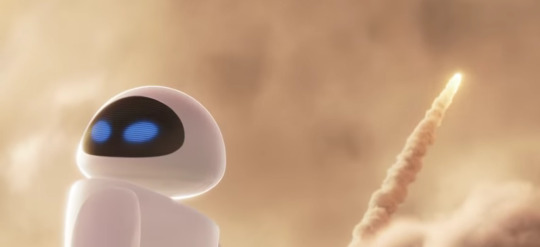
Wall-E is one of my favorite films; I would gladly kill and extort to bring the sequel I had in mind to life in any way; animatics would pleased me if nothing else but anyways. I love this film and one of the biggest reasons for that is the character EVE, a character that stuck in my mind longer than most if you can believe. So, better time than any, Imma just ramble about why I love this character. And, before we begin, I’m gonna say EVE is a girl, Wall-E is a boy due to my brain believing they were respectively female- and male-coded for most of my life but do NOT let this stop you from envisioning them however you please. If they’re both girls or boys to you, all power to you. With that said, here we go...
The Design
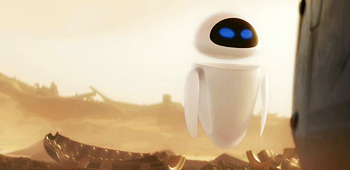
Now I’m not saying she has the greatest robot design ever; I don’t look at eggs and remember better days when I got to watch that film for the first time in my old house. But Pixar certainly knew how to make simplicity work to perfection. Simple shape, simple mechanics, simple movements. All feeling right at home with her coming from the more advanced future, especially compared to Wall-E where he’s literally a more grounded looking robot. Thematically, this design is fucking genius. A scouter robot with the ability to fly with ease and yet carries a literal arm cannon with incredible fire power. Both expressing how she can have her head in the clouds, observational when necessary, and yet trigger happy amidst the slightest inconvenience or surprise. *MWAH* What the fuck? It’s a great duality where the hard, more logical exterior possesses a sweet and approachable core just waiting to be shown and it’s wonderful seeing Wall-E, this literal block head, fumble his way into having a simple conversation with her. Now I can’t really disassemble how the programming in Wall-E works where they can behave like humans but follow objectives like a machine... but, I can try. With this scene.
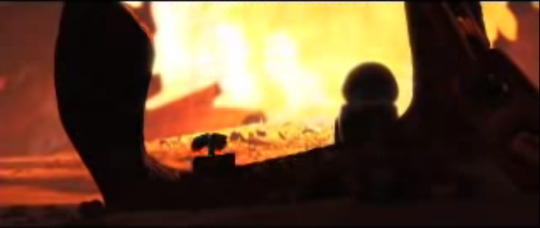
Now take this with a grain of salt, the inferencing is more to the imagination otherwise the fun of this movie is tarnished. But from this scene, it’s clear that in this universe robots can show feelings for one another but can’t be romantic with humans because they can recognize human emotions and reactions but do so in an automated sense. The film expresses their curiousity just enough to where their reactions to human things and functions are within reason and yet doesn’t toy with the viewer’s believability. EVE is capable of responding to Wall-E’s advances but doesn’t 100% reciprocate his feelings because Wall-E isn’t her directive (least not yet, that’s for later). Not to mention, she isn’t that adept at romance unlike Wall-E who, by being alone with Earth’s technology, was able to learn and process human romance through the Hello Dolly VHS and potentially other things over the years. So this conversation works with the two having their limited knowledge, we don’t know how much they know, and the film keeps focus on having a balance between somewhat logical reactions and minor impulsive humane reactions that makes them alive but only just enough so it doesn’t feel like them being robots is pointless... Phew. Speaking of which, you know what isn’t pointless? Her motherfucking buster cannon.
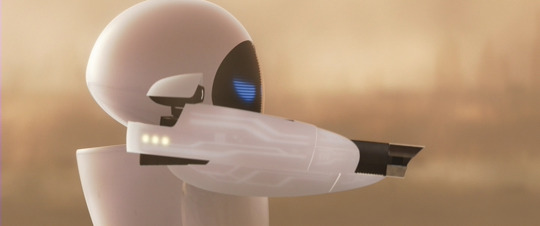
Her whole ass arm houses a gun capable of nuking an entire cargo ship in a matter of seconds and it makes sense that she’d have it cuz how can a scouter robot defend themselves but beyond that, it’s just so goddamn cool. Like yeah, I can express how this symbolizes about America and... how they want to fuck their guns or something but who cares. She has a FUCKING ARM CANNON and it’s badass, end of discussion.
The Hanger Moment

Much as I love the moment where the two are in space flying, I honestly say that this moment where the two are in Wall-E’s house during the darude sandstorm is incredibly important. EVE is reasonably taken to his home and naturally, when the lights come on, she looks through the stuff he gives to her. She gets to take it easy for once, things can be quiet after she blew up a whole ship, have a giggle or two at the trinkets he’s collected, with the cigarette lighter being a good tool that’ll be used for later.
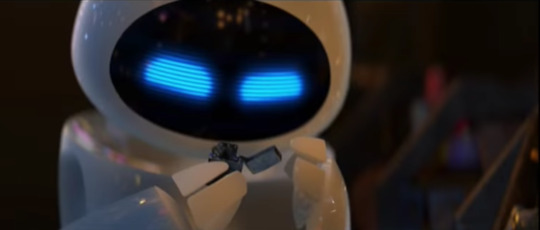
She’s curious, bouncy, still a bit quick on the draw, but is nonetheless taking in a lot this robot on Earth has to offer. It’s this and the small 1v1 they had before that is a lovely seedling to not only their connection but EVE’s development on her own, where we hardly need dialogue to show how she’s feeling about it all. And yeah, I’m with plenty of people to say that if this movie was just about the two of them being on Earth it probably would’ve been the greatest Pixar film of all time for many. Fortunately the plot kicks in when Wall-E shows EVE the plant, forcing her to go dormant, thus pulling Wall-E into an adventure on the Axiom ship. And I say fortunately cuz this is where EVE goes from good to great as a character.
The Axiom
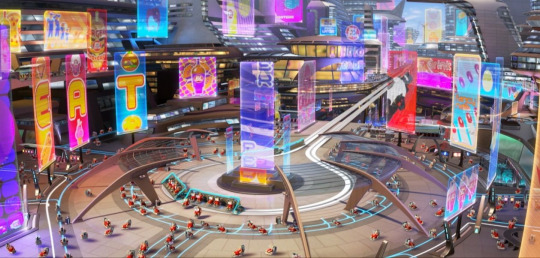
While it’s something where we all wish that this film wasn’t the densly plotted, society driven second half, I say the second half on the Axiom carries the film’s themes and character building for EVE to good heights. We enter EVE’s territory, the slick, iPhoney synthetic world where humans have become literal potatoes and everything’s more or less automated. For EVE, the first half of the film lets us see the more playful side of her and doesn’t mind being around Wall-E, but isn’t immediately won over with the concept of love. She’s still goal-oriented and trying to keep the two stuck on Earth would’ve made her arc as open-ended and ambiguous as The Good Dinosaur. Time on the axiom puts her original sense of thinking to the test when Wall-E tags along.

To share the bigger picture real quick, the human element of Wall-E is complimentary to Wall-E and EVE’s humane behavior. To quote RealJims’ honestly flawless analysis, “What better way to show the humanity in a robot than to be among humans that act like robots?” For Wall-E the robot, this works perfectly as a fish out of water story. His time on Earth affects not only a few humans, but other robots like MO and the secretary machine, as minor as it seems.
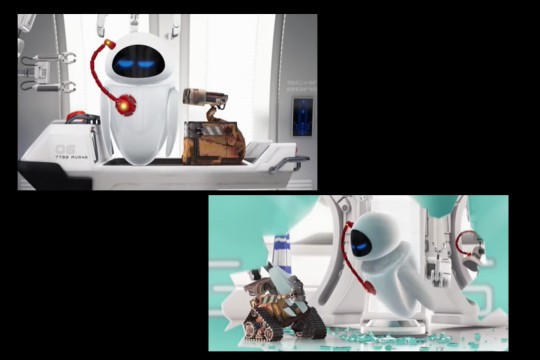
So when Wall-E seemingly fucks things up, EVE is rightfully peeved. His slip ups especially with the Diagnostics scene tests her goal-oriented nature and patience, to a tasteful comedic strength. Doesn’t mean they now turned Wall-E stupid, the film makes sure the monkey wrenches are only accidents from someone severely out of the loop of things. This leads them and us well into
The Depths of Space

The scene where Wall-E gets launched in the escape pod thrills me with joyfully painful suspense every time. EVE making a mad dash to him as Wall-E madly tries to get out of the soon exploding pod, leading to it exploding and we get this from EVE. The wide eyes of terror followed by the whispering “No”s gives me shivers every time I see it in full.

Now one could argue her concern was more for the plant getting destroyed, but I say she was more frightened at the idea of both Wall-E and the plant getting nuked. While Wall-E did make her mad, she nonetheless cared about him and wasn’t expecting the tiny bot asshole to send him to death. So it’s like, “Oh no, both my purpose and the one that helped me are both gone.”
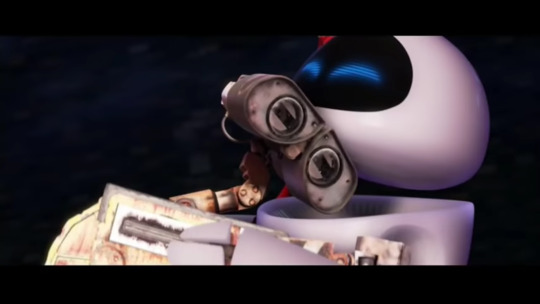
Luckily, thanks to some foreshadowing, Wall-E made it out alive with the plant in safe keeping and EVE seeing Wall-E actually care about her goal makes her beam with joy, being that reasonable spark that brings the two closer together. I mean if your love interest cheated death to help you out, why wouldn’t it? Everything about this moment is what made EVE stick with me long after I watched the film; the emotional journey the director was able to convey with her is so well-built to this point, it’s still amazing how they were able to do it with little dialogue or facial expressions. I especially love the emptiness we get of the two of them in space, where it adds focus to the two of them especially. But my god, that’s only half of it...

The space dance sequence between the two is still one of Pixar’s most gorgeous scenes. The way Wall-E is able to keep up with the fire extinguisher after having trouble in the film’s beginning, the wide shots of space, the lovely glow of the engines, the music. I especially like to think of this scene as a parallel to EVE’s initial flight on Earth. For her, it was that rite of passage after the touchdown and now she gets to share that same moment with someone she’s grown to like or appreciate. Then again, this isn’t the moment where EVE loves Wall-E. We’re close, but we need that one inch to finally show her the truth. That’s when she sees
The Recordings
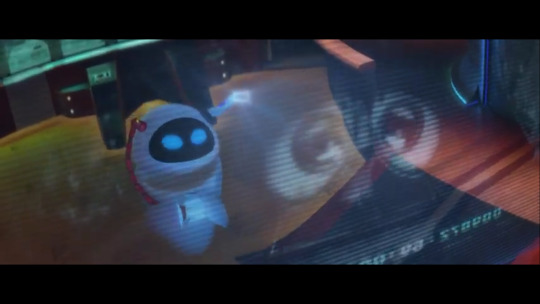
The moment where EVE gets to see the memories of her time on Earth, including her dormant stasis, is where shit finally clicks. She essentially gets to know how Wall-E felt not only about her, but about love. Even when she couldn’t be there, she sees now that Wall-E cared about her and is able to process what Wall-E processed when he looked at Hello Dolly at one point. Scene also works because getting her directive, or the plant, was generally done and done with, she finally gets time to focus on something else, on her feelings for someone else. This leads well into... the well that leads to...
The Dumpster Moment
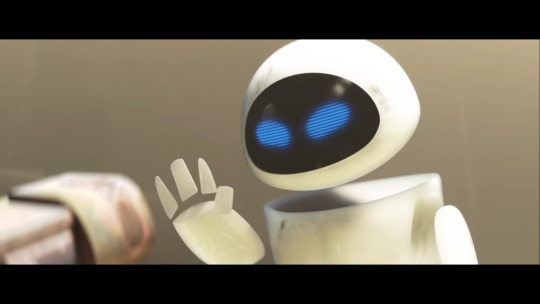
The scene with the recordings is where things finally click, but the moment with EVE and Wall-E in the ship’s dump is where it comes together. After getting betrayed yet again by AUTO, EVE’s concerns are now less with the plant and more for Wall-E and thanks to the moment previous, I can totally buy this. It’s teeth gritting seeing her try to rescue a now broken Wall-E from getting ejected into space and losing his energy thanks to a destroyed chip. So when we see her finally toss the plant aside and says Wall-E is her directive now, I tear up. It feels like a genuine, built up declaration on her part; the moment where EVE can rationally return his feelings ten-fold and truly be there for him. But that isn’t all to it, because Wall-E reasonably struggles his way to the plant to show that to save him, they need to get to Earth which means getting the plant back to the core of the ship.
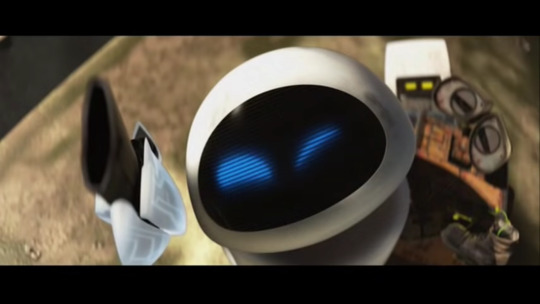
This gives EVE newfound resolve and puts that to the test, where she has to basically defect against AUTO who’s become the physical antagonist of the film. The escape sequence is a bit of a step down since putting humans in danger doesn’t really affect the film’s themes all that well, but I can’t argue that pitting the captain against AUTO is a bad climax.
The Death to Wall-E

Thinking about this film after so long, it is still pretty fucking shocking to realize how punishing they treat Wall-E in the final act. It’s even more shocking when you realize how the roles have reversed, where Wall-E focuses more on EVE’s goal with the plant instead of EVE herself and vice versa. Then again, I say it’s fair that they did this, to show how much Wall-E was willing to sacrifice for the one he loves which makes the painful wails we hear from EVE feel all the more impactful. Like you’re serious with her as she struggles to accept his death before they reach Earth. And speaking of Earth...
The Finale
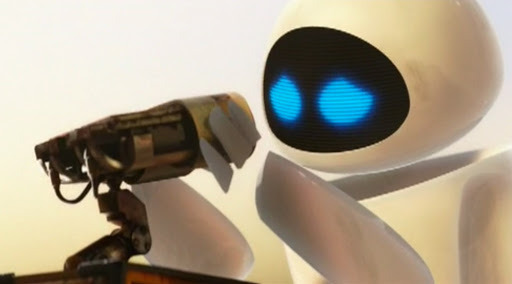
Now, I can’t help but argue it’s an unfortunate plothole that EVE is somehow able to fully repair Wall-E in spite of never fixing anything else in the film. Then again, it’s fucking pumping seeing her move quick to put him back together and it’s that final stomp on the heart when, even when he’s fully restored, Wall-E bares no memories of her or anything. You see her desperately try to get him to remember anything only to be met with an emotionless, reset shell. In finally understanding Wall-E’s feelings of love, she can’t really be with him. Until...
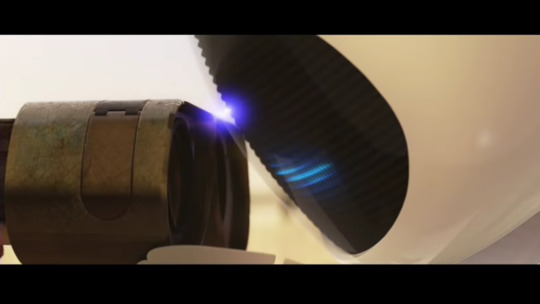
True Love’s Kiss Saves the day
I can get scientific with how getting his memories back was possible, but I won’t because the scene just works. It’s quiet, takes it time, and that last eureka moment with the two truly get to hold hands makes up for any scattered logistics. I’d say this is where Wall-E finally gets the love, but the same can be said for EVE, after everything she went through. I’ve admittedly seen a few talk about how the female lead is only valid through the love of another, typically male, but I believe what works 120% here is that the two characters basically have themselves figured out, Wall-E more than EVE, and EVE’s journey is never hindered for a sudden realization to love. She still succeeds in her mission, but the stakes for her have risen once she comes to terms with her newfound feelings and these feelings aren’t out of pocket. Wall-E has his feelings for EVE from the getgo, but dedicates to helping EVE with the goal, even if it means death. The connection they get to have is earned and is what drives the plot. EVE earns what she realizes she wants and that makes her a great female protagonist in my eye.
The Conclusion

Wall-E is a pretty warm movie; a film how the love of two brings humanity to salvation and vice versa. How EVE and Wall-E’s love is synonymous to the intertwining of modern and older technology to shape the world. But honestly, that probably wouldn’t have worked as well without how great they made EVE as a character. Wall-E is great too, but it’s astonishing to see EVE’s journey with Wall-E and show her natural growth of understanding something as warm as romance. Her journey is pretty synonymous to how I feel with the movie overall. The time we get of them on Earth is symbiotic to the time we get in space; we get an intimate journey that expands to a film about society but remains personal and intimate nonetheless. And with EVE, we get this superbly fleshed out character that’s emotive, understanding, and above all gets a resolves that’s awesome to see every time I catch or just think about this film. What else is there to say?

They’re the Best.
129 notes
·
View notes
Text
Feeling sentimental so this is a thank you to Thomas Sanders. I’ve only been watching your videos for about a year now and you and your friends have already changed my life for the better.
I’m not exadurating when I say you’ve taught me more than my school has in a long time. Not only that, but you manage to make it entertaining. The result being that now, while I don’t understand half of what my teachers are trying to tell me, I’m am 100% prepared to explain the basics of Max Stirners philosophy ‘the ego and it’s own’ should the opportunity arise. I was able to tell my mum who Imanuel Kant was when he was mentioned in a tv show as well as reassure her that they weren’t saying a very different word😂
It’s also because of your Q & Gay videos and Joan that I realised I’m asexual. When I first watched them, I identified as bisexual because I was confusing the different types of attraction. However, I knew something was up but I didn’t know why. Joan basically explained in the follow up to Q & gay pt. 2 that they would find people really beautiful but then think “oh but I don’t want to sleep with them so I guess I’m not?” And my immediate reaction to that was “wait...that’s what’s supposed to happen?! Wait-I’m supposed to want to do what??!!” And after a few weeks/months of questioning and research, I started identifying as asexual which then lead me to also identifying as aromantic. Joan being in that video and being allowed to talk about their experiences stopped me from potentially experiencing a lot of confusion and pain. It’s because of the both of you that I found a community of people I could relate to and supported me. Not only that, but it was a fander online that first told me I was welcomed and accepted into the ace community.💜
It’s also because of sander sides that I found a lot of musicals that I’m really into. Beetlejuice, be more chill, dear Even Hansen. I found all these musicals and so much more really cool stuff because of animatics based around your characters. And it was musicals like DEH that really helped me during my hardest time in my life so far. I wouldn’t have had that if it wasn’t for you and your friends inspiring so many people.
You’ve also helped me and my relationship with intrusive thoughts. I grew up religious and while I’m not super strict I still love my God. However, DWIT was a massive eye opener for me, especially when Logan says “five out of the seven deadly sins are committed in your head.” Legit, has to take a moment to think about that for a second.😂 I honestly can’t express how happy I felt when I realised I didn’t have to hate myself for having intrusive thoughts. That it wasn’t something I needed to be punished for and that they just happen. Since then I’ve been working on accepting them as a natural part of me and have made loads of progress.
Despite not being my favourite episode, moving on pt. 2 is the episode that means the most to me so far. To provide a bit of context, I used to be best friends with someone a while ago. What I didn’t know, however, is that she was a very toxic person. I’m not going to go into detail (mostly cuz there is no real point and I don’t really wanna think about it again) but basically after gaining my trust and isolating me from all my other friends, she started bullying me. She told me that she hated me and proceeded to call me names. Please keep in mind I thought of her as my best friend and at the time and she was pretty much my only ‘friend’. She then later apologised but then repeated this the next year accept with our mutual friend joining in with the name calling. 3 years later and she was (and is) no longer in my life. However, for some reason I couldn’t stop thinking about everything that happened. Everything she did. I honestly couldn’t remember a single good memory with her and the few foggy ones I could recover felt really fake. But then I realised something. A part of me missed her. As screwed up as it sound, there was a part of me that once loved her and I think I missed having that version of her in my life. I never got the chance to mourn the loss of that friendship. I was trying desperately to get closure but didn’t know how to do it. I was so confused. Why did I missed her after all these years? Why couldn’t I just let things go when everyone else had? Why did I still hold onto everything that happened? I know moving on is about something complete different but a lot of it rang really close to home. “One step at a time, kiddo. I’m rooting for ya.” “How you’re reacting for however long is completely normal-not bad, not strange, not stupid.” “Moving on is not the same as moving forward.” I cannot express how much I needed to hear that (and those are just the quotes I remember off the top of my head.) That video really helped me when I was trying desperately to gain some type of closure while grieving a now dead friendship. It remains to be the episode I value the most because of the role it had in my grieving process.
While moving on means the most to me, a close second to that is “embarrassing phases.” (No, not just because I’m a Virgil Stan who loves Halloween. That’s just a bonus.) Speaking as a teen still going through phases, that episode honestly took the words out my mouth. A lot of the time I’ll feel really insecure about liking certain things and I was kind of falsely taught that phases are a bad thing. That they’re just artificial. I felt like I was just faking being I was/am because “it’s just a phase.” When you said “whoever you are right now, you’re real. Don’t let anyone tell you otherwise.” I honestly wanted to start crying. I didn’t realise how much I needed to hear that.
And finally, the most recent TSS video POF seriously felt like you’d read my mind. At the time of its upload I was thinking about a lot of morality issues and struggling with them, feeling guilty for not being able to contribute more and help people, feeling guilty for being selfish sometimes and also desperately trying to find a balance between selfishness vs selflessness. So, yeah, I’m sure you can see how I was able to relate to it😂. I’m still struggling with a lot of that tbh but it’s good to know I’m not alone in my feelings and to be able to gain some form of clarity on the topic.
To put a long story short, Thomas, I’ve only been watching your videos for about a year now and you and your friends have changed my life so much already. I seriously can’t thank you enough for that. You and your friends are amazing people and I’m so greatful for you all. Love ya💚💜
@thatsthat24
18 notes
·
View notes
Text
Nenad got his first character animator job in 2004. Since then he’s been involved in a wide array of roles on productions in Serbia, UK, Netherlands and Austria. In 2015 he took what was supposed to be a temporary position as a layout artist at Arx Anima studio in Vienna, quickly got obsessed with the work and soon became the department supervisor, spending around 3 years working on Talking Tom and Friends animated tv series. His affinity to explore all aspects of the production process subsequently landed him the position of production manager, leading the final 11 months of the project, to its completion. Currently based back in Belgrade, collaborating on new projects locally.
We can see Nenad’s talk “Cheating in Layout” on November 17 @ 19:00 – 20:00 at CGA2018 conference
So great to see you on CGA speakers list this year. What’s new in your world?
Glad to be a part of the conference! I’ve recently moved back to Serbia after some years working in Vienna. The project there was quite long and challenging so I’ve decided to take a bit of a break and spend a while at home to regroup. Quite enjoying it to be honest, it will allow me to start whatever is next with maximum energy, especially since an opportunity to have time off is not always there, for me it was almost always a direct transition from project to project.
Freelance Animator, Layout Supervisor and finally Production Manager, that are quite different roles in the animation production. How did that happen?
I’ve always struggled with keeping one career path. I’m interested in too many things, and we were taught growing up that you want to find the thing that you’re good at, and stick to it, but that direction has never worked for me. Animation is the one thing that I managed to keep going for longest, just because it’s such a versatile field. Every time it’s a different approach and different challenges. Still, I don’t like doing any one thing for too long, and moving to layout was just a fortunate coincidence. Arx Anima studio in Vienna was starting work on season 1 of “Talking Tom and Friends”, and the layout department was a bit short on staff. Kris Staber, the CEO of Arx Anima and my long time friend and associate asked if I would temporarily fill one of the positions, with the idea that I would switch to animation later, and I went for it. Didn’t take long for me to get addicted, and a couple of months later I became the supervisor. Now, even though I’ve always been involved and interested in multiple roles (rigging, motion graphics, TD work, etc.) all of them were in the creative sector. The production side of things always sounded too serious and responsible, not the words that I find too appealing, but again, the way that events turned during season 3 of Talking Tom, brought me the offer to step in as production manager, and I accepted it.
This slideshow requires JavaScript.
“In season 1, episode 37, we introduce a character Will Z, who is a skater. Since I skate in real life, I kind of overstepped and almost did the blocking in all the sequences with this guy.”
From previous experiences in these roles, can you compare them in relation to responsibility levels?
There is a lot of difference. As an artist you are the creator and you want to take care of your shots, to try and keep the supervisor and directors happy but still have fun doing it. The supervisor role is a bit different in that the scope is greater, instead of a shot or a sequence the whole episode being shown to the directors and then to the clients, you want to make sure it looks as good as possible, while still allowing your team artists’ creative freedom to come through. It’s tough but a lot of fun also, no doubt. Production management, on the other hand, brings the challenge and stress factor to a whole new level, the margin for error is much smaller, and the decisions you make now have an impact on the company itself, there is a lot of politics and diplomacy involved. You start tackling things like hiring new people and also letting some go, and that is never easy. Finding the fun aspect in that line of work is much harder, but it’s possible. You have to remember you are still making an animated show, and at the end of the day the accomplishment you feel is much greater, so like everything else, it’s just about finding the right balance in how you deal with the good and the bad of any given day in the studio.
Arx anima layout department team, season 3
What is layout and where does it live in the Animation TV series production?
In 3d animation, layout, sometimes also called previz, depending on the level of detail the project requires, is the step between hand drawn 2d storyboard/animatic and animation. It’s where you set up the shots in 3d environment, using the actual character models and assets, and you get to see how your shots will actually look like, for the first time. It’s extremely important because the issues that are solved there can save a lot of time down the line. Putting enough time and people on it is essential on any bigger production, like a series of a feature film. It’s digital cinematography in a way, you are dealing with composition, staging, flow of shots, and start to see the limitations of what the script or the storyboard require. It is also directorial to an extent, because you design each of the shots, even though they are defined in the storyboard, they don’t always work the same once you switch to 3d, and that’s where you can get really creative, not just making it work but also making it better. Relationship with the directors is super important, you want to provide them with the best way to tell their story.
Arx Anima studio crew
Your CGA 2018 talk is all about cheating. Is this about being street-smart or something else?
Cheating is essential. Every department cheats to an extent, but I feel animation and layout do it the most. It’s not about deceiving your audience or lying to them, in the most basic way to explain it, it’s about manipulating the elements of the shot to give the audience a stronger telling of the story, accentuating the right things at the right time, pushing the composition from a physically correct one to an esthetically better one and making sure no one can tell that you did it. Goes without saying that this is super fun.
youtube
“Episode 38 is also interesting, because I was approached by the director, who knew I’m making music as a hobby, to try and create a soundtrack for the “thermostat universe” part.
We worked on it together for a few days and the final result actually made it into the episode. I don’t care much for credits but was happy to be listed as music composer on this one.”
Judging by YouTube views numbers, Talking Tom is hugely popular with young parents and their kids. How long did it take and how many episodes are there?
The Talking Tom brand was already quite developed when we began work on the series, and the quality standard that we went for was quite high, so it didn’t take long for the show to become popular. I don’t have the actual statistics but within the first couple of weeks of airing, the view counts per episode were already in the millions. There are 104 full 11-minute episodes, and a few smaller “webisodes”.
youtube
Have you had any special tools to help you speed up the production?
Like every bigger studio, we had our pipeline and development team, who worked hard to build countless proprietary tools and scripts. These tools definitely have a very high spot on the list of things that made the whole project possible to pull off.
Arx Anima studio crew
Back to Belgrade? Can you compare your experience of working in 100+ artists facility and working locally in Belgrade?
Belgrade is my home, I’ve lived in a few different countries over the years but somehow always end up back here. I just feel most relaxed and there is just something about your birthplace that you don’t feel anywhere else. That said, the working structure here wasn’t as organized before as it is abroad, but has been picking up a lot in recent years, and I believe we are quite close to being equal to the rest of Europe in this regard, if not already there. The atmosphere in the studios here is totally unique though, and I enjoy it a lot.
Is there a particular talk at CGA Belgrade that you are looking forward to sitting in the audience as an artist?
I’ll be a bit biased here and say all talks held by local speakers. I’ve been away for a few years and out of the loop on what’s been going on in our industry here so I’m looking forward to hearing their stories and talks.
Thank you, Nenad! See you at the CGA2018 conference!
Follow Nenad on Instagram and LinkedIn and IMDB
You can see Nenad’s talk “Cheating in Layout” on November 17 @ 19:00 – 20:00 at the CGA2018 conference. Register for the free tickets below.
Once again, November becomes the month of computer graphics, as CGA Belgrade hosts its two-day journey through the latest news, trends and developments in the VFX industry. We have worked especially hard this year to expand our main program, which we are proud to announce will feature two separate tracks! For big-picture thinking and groundbreaking ideas, make sure to look for the Know It All sign. For hands-on training and insider tips & tricks, don’t miss the Know How stage.
Nenad Mitrovic, Animation production (CGA2018) Nenad got his first character animator job in 2004. Since then he’s been involved in a wide array of roles on productions in Serbia, UK, Netherlands and Austria.
1 note
·
View note
Text
Search – A Conversation with the Editors
Editors Will Merrick and Nick Johnson co-edited the film Search, which premiered last weekend at Sundance 2018. Search was written by Sev Ohanian, and is the first feature for director Aneesh Chaganty. It stars Debra Messing and John Cho, and features a story told entirely on computer screens. While visiting Sundance last weekend, I had a chance to sit down with Merrick and Johnson to talk through their process as co-editors on this very unique project.
PVC: So how did you both get involved in this film?
Merrick: Our film tells the story of a father (played by John Cho) who when his daughter goes missing decides to look in the place nobody else has looked, on her computer screen. The entire film unfolds on his computer screen and other screens. I got on the film because I met the director Aneesh through USC. He had just left his job on the creative film team at Google, and he rang me up with a movie possibility.
Johnson: I went to USC with Aneesh, I knew him from classes, and we were friends. Then he went off to New York to work at Google, and I hadn’t seen him in years. Then I got a call from him asking me to edit “Search,” and asking me to meet up with Will. Will and I met up because we didn’t know each other previously. Then we decided it would work, we could work together.
Merrick: Aneesh was hired at Google after directing a spec spot for Google Glass, and they brought him on to the creative film team. I had edited the spot that got him that job.
Johnson: I think there’s something where you want to find people that are ambitious and are going to put everything they have into a project. I think Aneesh felt comfortable that we’re creative people, Will and I, and we are also hard workers. I think there was this understanding that we were going to go 100 percent the whole time.
Will, Nick, and Aneesh in the edit bay
PVC: How do co-editors work on a project like this, how does that collaboration work?
Johnson: It’s perfect for this project. There was actually very little discussion about our dynamic. It just kind of organically happened. Because this is such an unusual film, it’s essentially an animated film. The script was incredible, but it was kind of unusual because of it being told entirely on screens. You couldn’t quite break it down into scenes like you traditionally would, so what we did was we just drew lines in the script and broke it into 26 sections. We lettered the sections alphabetically, and Will took section A, I took section B, and then we just moved that way through the movie. Then when we went into start doing the second passes, we just swapped so that we were constantly refining each other’s work.
Merrick: This happened enough times that we really can’t even remember who started what anymore. We both worked on every sequence.
Johnson: Yeah. It got to the point where it’s like, “L has a bunch of notes but Q really needs some work.” Like, “I have Q open, I’m going to take Q, you take L.”
PVC: Were you guys editing side-by-side or the same location?
Merrick: We were working pretty much in the same room.
Johnson: There was a door you could close, so it was actually perfect. What would happen is Sev, Aneesh and Natalie would come in, and they might be doing notes with Will, and meanwhile I would be implementing some notes in the other room. Then they’d come over work with me.
Search filmmakers at an ASC event at Sundance 2018
PVC: So the film takes place entirely on computer screens. Can you explain that?
Merrick: Telling a movie through a computer screen is not an entirely new idea. There have been movies like “Unfriended” by Bazelevs, the same company that did ours. Those films tend to be told in real time and in wides of the screen, kind of “Paranormal Activity” style. What we wanted to do with our film was in the same way that early movies were wide shots like theatrical vaudeville acts. We wanted to go in and sort of discover what coverage is in the computer world. We will, for instance, have a FaceTime call where we’ll cut to one person…say John Cho is talking to his daughter, then we cut down to her sort of like a reverse.
Merrick: At first, we didn’t think it would work. We thought it would be against the rules, but we found out we could make a shot reverse work by punching into the small screen where you see yourself and then punching back out to the wide.
Johnson: It was a lot like DP’ing, and we actually have a “directors of screen photography” credit on the movie.
PVC: Is that a thing?
Johnson: It is now. It really was like shooting a movie. It’s challenging because unlike a three dimensional world where you can kind of get off-axis and do your coverage that way, we were all on a two dimensional plane. So the tricky part was the shot sizes had to be significantly different when you were cutting, which gets really hard when you’ve got camera movements happening, and you might find yourself in a little middle area.
Merrick: One of the most mind blowing things we discovered was that in some cases we could cut from one punched-in area of the computer screen to another punched-in shot, without going back out to a wide. You don’t think it will work, but you just try it and you discover you have almost as much film language in there as you do in real life.
Johnson: “Unfriended” is really effective, it’s wide real-time, but we wanted to punch in. We had seen this in a “Modern Family” episode, and in “Noah,” it’s a great short film. “Nerve” did this, but all of those movies wouldn’t cut.
Merrick: They do a fast zoom. “Voosh, voosh, voosh.”
PVC: They were doing that to try to retain the geometry of the scene for the audience?
Johnson: Exactly.
Merrick: Our first cut was like that. It was actually Sev who came in and watched our first cut and told us, “Guys, what are you doing? Just cut.” We were like, “Whoa,” when we started trying it, and it worked.
PVC: So as a DP, one of the tools I can use for covering a conversation is the OTS. It’s a simple way of establishing the geometry of each person in the scene in relation to each other. But you don’t have an OTS on a flat 2D screen.
Merrick: Even when we’re almost showing a video full bleed, we usually show the edges of the video. We’ll frame with edges of browsers or videos.
Johnson: We felt like full bleed was kind of visually uninteresting, and just didn’t keep you grounded in what you’re looking at. In FaceTime calls, it’s nice because you have the little face in the bottom, so when you’re cutting to the one shot, you’ve got both people.
Merrick: It’s like a wide. That wasn’t fun to edit.
Johnson: Those are extremely difficult because unlike a shot reverse, you always have both shots playing at the same time. They have to be timed up exactly right.
PVC: Were those conversations shot in real-time on both subjects? Or were they shot separately?
Johnson: They did in most cases. I think it was helpful for the actors and for pacing, but what we found was even in those situations, the pacing was off a little bit.
Merrick: Like you always want to make the little tweaks while you’re cutting and we didn’t have the freedom to do those at first until we came up with the cutting idea. Because no matter how good your actors are, you do want to play with it.
PVC: Do you do any morph cuts or anything like that?
Johnson: We did some morph cuts. We also used one trick that gave us a lot of, I don’t know, consternation …
Merrick: We were very nervous about it, but we tried “glitching” as a transition. We tested it on a lot of people and we found you can glitch between multiple shots if you’re very subtle about it.
PVC: What do you mean?
Merrick: I almost feel weird even talking to you about it. Occasionally, it freezes up for just a little bit and it’s organic. We data moshed it slightly, just slightly, not crazy.
Johnson: We were watching it and we’re like, “This is super obvious.” I kept telling the producers, “Please ask this in our test screenings.” They were like, “It doesn’t bother anyone.”
Merrick: Everyone in the test screening were like, “What glitches?”
Johnson: We actually ended up compressing it and like pumping out super tiny H.264s to get that kind of blockiness.
Merrick: Yeah, we’d export in H.264 at like .5 bit rate, then export another one from that at like .2 bit rate. Because we used glitch software, but it’s too obvious.
PVC: Okay, so on the live action thing, I’m just trying to wrap my head around this. When they filmed the live action footage for these conversations on screen, did they film it with the actors facing each other? Or were the cameras in separate rooms?
Johnson: Well, the system that they rigged, we had nothing to do with. It was our DP, Juan Sebastian Baron. It’s like genius. I think Bazelevs has kind of slowly created this process.
Merrick: Sebastian rigged a system where basically the actors could look at each other on a FaceTime call while a GoPro is doing the actual filming. They were getting a live feed from each other so they can perform, but they’re in separate spaces.
Johnson: We actually created a full animatic seven weeks before they shot, and we pumped out wides for every scene with information like “Here’s the finder window. Here’s where John Cho will be.” Then the script supervisor was able to show them “This is where your eye line is.” The animatic helped us a lot because the actors’ eye lines were always, for the most part, pretty accurate.
PVC: This sounds like an incredibly post-heavy film. Talk to me about some of the tools you used.
Johnson: Our overall process was in three stages essentially. There was pre-post-production, post-production and post-post-production.
PVC: Oh god.
Johnson: We had rehearsals with Aneesh before we actually got in the room. Then once when we got in the room, we spent seven weeks with Sev and Aneesh, creating an animatic that was used then as a model for shooting. We were using Adobe Premiere Pro for everything at this point.
PVC: For the animatics? How do you do that in Premiere Pro?
Johnson: What we were doing was, we were using ScreenFlow. None of this movie ultimately was screen recorded but we were using ScreenFlow and taking screenshots, and then bringing those assets into Premiere Pro.
Merrick: There’s like no other place where you start with a totally blank slate as an editor. Like we didn’t even have storyboard slides.
Johnson: You take the script and you’re like, “Well, let’s make this thing.” So we opened Finder, we start screenshotting. We opened FaceTime, Aneesh would take pictures of his face, kind of performing the scenes. He would record a voiceover until we built a full cut that was shown to the crew. They were all sort of like, “Oh god, we have so much work to do to make this play.” The animatic was all these jumbled pieces, screen recordings, like screenshots of Aneesh’s face making faces with his lines underneath it. We nested everything. We decided early on that nesting was the way we had to go.
PVC: Why is that?
Johnson: We needed to be able to shoot around the desktop, so we decided in the nest, we would production design, essentially, a wide of the desktop, put all the icons, we would do all the movements, all the blocking and staging in the wide and then we would nest it and then cover it with the scale and position attributes. Every time we had a timing change, we had to go into the nest, change the time, punch back out of the nest, and move the camera moves for everything.
Merrick: This was one of the weirdest things to get my head wrapped around, because we were editing not only temporally, we were editing spatially in a way. If we moved anything, rearranged anything on the desktop, we would have to then adjust all the timing. Then we also had almost parallel sequences going on in a weird way, because we had the macro edits on the nest.
Johnson: We would duplicate our edit, and we’d have to duplicate every nest inside the edit, or else we would destroy those nests if we made changes. So we had all these macro edits and then if we wanted to make this five frames shorter, we’d have to go into the nest, move everything in the nest over five frames, then step back out and move all the other edits over five frames.
Merrick: A “Null Object” in Premiere Pro would be great. We could have parented everything to a Null Object and been able to just keyframe that around it.
Johnson: Which is how we did it in after effects.
Merrick: The animatic became our foundation for the movie, so as they were shooting we cut the live action into the animatic. Then refined that with Aneesh, Sev and Natalie into like a director’s cut and a producer’s cut, and we showed those to audiences because we knew once we moved to After Effects, we’d be talking months for small edits. So we did a hard picture lock, and moved everything into After Effects where we, with our VFX company Neon Robotic, created Adobe Illustrator files of almost everything in the computer interface.
PVC: Everything was recreated? You did the screenshots, you put the video and all those assets on top of that, you keyframed rough moves, then recreated everything again? Is there a faster way?
Merrick: We always thought there would be. We never found it.
Johnson: If there was a better way to screen record your desktop in Vector, or screen record on a 16K monitor.
Merrick: Bazelevs is actually working on a software that will do this, but it’s just, it’s so extremely hard to create that it just wasn’t ready by the time we needed to use it. Basically, the decision that made us have to recreate everything was they were punching in for so much coverage that even if we had gone for the pixelated look, which we just creatively didn’t want to, it just wouldn’t work.
PVC: So you had to recreate the interfaces themselves in Illustrator, to avoid pixelation when you punch in for coverage. It’s icons and toolbars and all that kind of stuff, right?
Johnson: Yeah, and button states.
Merrick: We have like a Google Chrome bar that has five possible tabs, because we figured out that was the most we ever needed in the movie. It has all the button states for when you close it, click a new tab, we can add new data. Basically, the VFX company we were working with, Neon Robotic, created that large asset with all the tabs and fully customizable. Then we would take it, cut it in After Effects for every scene and make it what it needed to be for that scene.
Johnson: We basically would have like in a folder, 35 Illustrator files numbered in order. So when the the mouse goes up, you got the hover state. He clicks it, and it’s foregrounded. Then also, we had to worry about drop shadows.
Merrick: A funny thing that will never make the movie or the interview is the pixel aspect ratio of the Illustrator files is the same as the size on the computer. Like if there’s a 10 pixel bevel, we just made it 10 pixels in Illustrator, and so we could make things exactly … We made it happen in like a 2048 by 1152 screen, and you could just make it that size in Illustrator and it comes in perfectly.
PVC: Would you have signed up for this if you knew that it was going to be this hard?
Merrick: Barely, but yes.
Johnson: I would say yes. But I was constantly telling myself this could not possibly be the best way to do this. I was like, “There’s got to be a better way.” I would spend maybe a couple of hours digging around, playing, experimenting, trying to find a different way and I’d always just inevitably come back to “This is the way we have to do it. We have to just animate every single state with Illustrator files.”
Merrick: I didn’t even think it would be half as hard as it was but, also I’m really proud because I think we did something that hasn’t been done before.
PVC: Well, that’s the thing. This film is unique it its time, but I think it might also be unique going forward just because the barrier for entry to make a project like this is so much freaking work.
Johnson: To be honest though, as far as if you compare this to animated movies, it’s like probably nothing. It was just the fact that it was me and Will doing all this I think. It was just a two-man sort of job with the help of Neon Robotic on the technical side. Creatively, we had a whole team, but that’s what made it so challenging. So we discovered you can find all of the icons in your computer in a folder in Mac, but they’re maxed out at like 125×125 pixels. And in our punch-ins, sometimes we’re like right on icons.
Merrick: There’s some icons that have never been as big as they are, until this movie.
PVC: I haven’t had a chance to see the film yet, but you’ve got FaceTime calls, you’ve got Finder interfaces, and texting I imagine? I’m just trying to think of how many different communication techniques can you use on a computer? What options did you have to tell this story?
Johnson: I think that’s where Aneesh and Sev, their original script was brilliant. Because I think whenever anyone watches a screen movie, you’re kind of waiting for like, “Okay, how are they going to get away with this? How are they going to cheat?” Sev and Aneesh worked really hard in making a really good narrative and a really good thriller with a great story. Then they worked to find ways to put that on the screen that didn’t feel contrived in any way.
Merrick: Yeah. I think it would be okay to say that at one point in the film, we moved to say news footage, things like that, and you can actually see the actors in there as well. We do have options kind of using video streaming occasionally. They use FaceTime a lot, but the texting…honestly, you can have a compelling scene just all on text messages.
Johnson: That was pretty surprising to us. That was a big challenge, rhythmically you would have a whole dialog scene taking place on chat, and there’s like a whole rhythm that is very foreign. As an editor, you don’t really edit chats like that, like go back and forth.
Merrick: Like if you cut in, and then a message appears, it’s weird. It’s like drawing. You have to like do all these weird tricks.
Johnson: We had a lot of tricks with cutting, because you want to cut on motion a lot of times, but everything happens on one frame in a computer. We didn’t have motion.
PVC: Don’t texts kind of “bloop” in a little bit?
Merrick: They blooped a tiny bit, yeah.
Johnson: Yeah, so we were always trying to exploit those little movements. We used the mouse moving in and out of frame a lot.
PVC: That’s your person wiping the frame?
Merrick: Yeah. Sometimes the mouse just jumps to another place, but you don’t know notice because we’re cutting at the same time.
Johnson: I think you pace it like you would a conversation. You’re not necessarily just stuck in shot reverse, shot reverse. You’re going to have your two shot, you’re going to have your master. Your two shot would be like this wide framing.
Merrick: We tried to keep the frames somewhat narrow and then we would usually start on that and then whenever there was a particularly important line, you could cut in for the closeup. We didn’t do too much cutting back and forth but like you could have one up here, and then like slide over to where they type and see the response be typing.
PVC: Ah, so that would be more like a traditional pan over to a reaction?
Merrick: Yeah, yeah, yeah, yeah.
Johnson: That was something that we had to learn ourselves I think. I totally get the impulse to want to just follow the mouse everywhere and not cut. It took us a while to understand that we can do these things, and by the end it was just like editing a normal movie.
PVC: Ok, so the 16:9 aspect ratio doesn’t exactly fit a computer screen, right?
Merrick: It does actually. We may have cheated it very slightly, but when we go out to the full 16×9 wide, it looks like a MacBook.
PVC: Did you find that wide framing to be an impediment when you’re cutting around stuff? A text message thread is not really that wide, it’s kind of square, right?
Merrick: We don’t go out wide often. Normally it’s for effect.
Johnson: That was one thing that Sev, our producer, really said early on. As soon he saw the animatic, he said we should be reserving our wides for really important beats.
Merrick: Like you never use a wide as your default. You never default to the wide.
Johnson: The nice thing is that everyone’s familiar with the layout of a computer screen, so we can kind of use that to our advantage. It’s not like you need to, like in a normal scene, live action movie, you have to establish the space at some point early on maybe so that people aren’t confused. We could start a scene on a text notification, for instance, and not worry that people are going to be like, “Whoa, where are we?”
Merrick: It’s funny to even play with that sometimes. There are times where we start in closeup, and you don’t know where you are yet, and you slowly find out through context. Our best compliments were after a lot of our test screenings people said, “I totally forgot everything was on a computer screen.”
PVC: So I imagine that you used the full Adobe tool set on this project.
Merrick: Most of it, yeah. Mostly Premiere Pro, After Effects, Photoshop, and Illustrator.
Johnson: Yeah, we didn’t really use InDesign. We used Lightroom a little bit, for some photos we shot.
Merrick: We even used SpeedGrade. It was our DPX viewer.
PVC: This was before … I guess SpeedGrade has since gone away?
Merrick: Yeah, we found a way to get it back.
Johnson: SpeedGrade weirdly was the best DPX viewer we could find. But we did color, we did do almost all of the primary color in After Effects with Color Finesse.
Merrick: We found a colorist, Zach Medow, who could do it.
Johnson: Zach was one of the only people who could listen to our workflow and not laugh us out of the room. He understood what was going on in our sequences. He had to color every live action element separate from the screen without ruining the screen. He was amazing.
Merrick: He had no playback. It was terrible. Just the worst conditions you could have for a colorist. But he did an incredible job. Like he nailed it. We had a pretty short amount of time, and he nailed it.
PVC: Sound design probably plays an important part in this sort of film? Who did sound design and how did that process work?
Johnson: A company called This is Sound Design did it, and this was actually probably the most traditional part of the process. I don’t necessarily want to speak for them, but I think it’s pretty safe to say that they had to also wrap their heads around the rules of this kind of film.
Merrick: Something that was weird…Foley for clicks in a keyboard suddenly becomes very critical, like you have no leeway.
Johnson: There’s a lot of character.
Merrick: You could show emotion through the clicks and through the keyboard, like how hard somebody’s typing. They did a great job with that. Every time we’d go to … I don’t want to explain how we go between computers, but when we do, it’s a different mouse, different keyboard.
Johnson: Each computer has its own unique keyboard sound and click sound.
Merrick: Then they would pan just a slight ambiance around the room, so that you kind of felt like you were in a space and had something to hear. It’s very hard because a lot of computers, there’s not, you kind of have to justify sounds because you don’t want to just sit and it’s quiet. It’s very music heavy too.
PVC: Was there like hum from fans? Did they go that far as well?
Johnson: Yeah, yeah. I think they would have birds, they would have a lawnmower in the distance for like afternoon. Like room tone hum. Honestly, it’s pretty traditional treatment, it was just, I think, tough to wrap your head around the rules, especially with typing and clicking. And I think David’s voice is actually panned a little bit. So you have this feeling that David is right with you, and the people on the computer are just in the center track.
Merrick: They did a lot of great futz work too, because if you’re talking to somebody on the phone, it has to be just distorted enough but not distracting.
PVC: Thanks so much for your time, and good luck with the premiere!
Sony Pictures Worldwide bought the global rights to “Search” the night of the film premiere at Sundance, and a theatrical release is expected.
The post Search – A Conversation with the Editors appeared first on ProVideo Coalition.
First Found At: Search – A Conversation with the Editors
0 notes